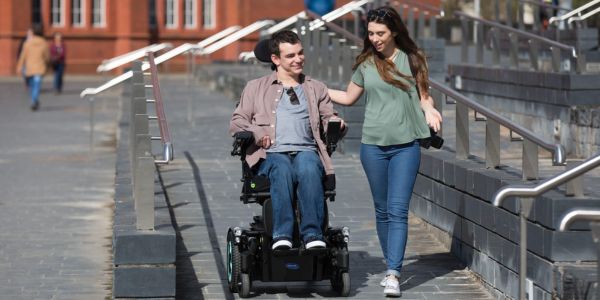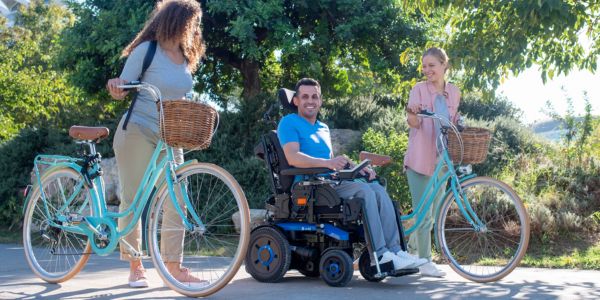An occupational therapist’s mission is to provide compassionate care and support to individuals facing physical challenges, helping them regain independence and improve their quality of life. Among the most intricate and demanding cases we encounter are those involving quadriplegic patients.
Quadriplegia, also known as tetraplegia, presents a unique set of obstacles as it affects all four limbs and the torso due to injury or illness in the cervical region of the spinal cord. The impact of this condition extends beyond the physical limitations, as quadriplegic patients also grapple with emotional and psychological barriers that require specialised care and attention.
In this post, we embark on a journey to explore the multifaceted world of working with quadriplegic patients. We will delve into the complexities they face daily, as well as the intricacies of delivering specialised care to meet their individual needs. By gaining a deeper understanding of the challenges and considerations associated with quadriplegia, we aim to equip ourselves with effective strategies and approaches that can enhance the lives of our patients.
Comprehensive Assessment and Goal Setting
In the intricate world of working with quadriplegic patients, comprehensive assessment and goal setting form the foundations of effective care. Understanding the unique challenges and capabilities of each individual is paramount to tailoring personalised treatment plans that inspire progress. Due to the complex nature of their condition, it’s important to explore their medical history, level of injury, and current functional abilities.
It’s important to assess many areas, including mobility, self-care skills, communication, and psychosocial aspects. Mobility assessment evaluates the patient’s ability to move independently, transfer between surfaces, and embrace the assistance of innovative devices such as wheelchairs and mobility aids. It’s equally important to explore each individual’s self-care prowess, understanding how well they can perform everyday tasks such as grooming, dressing, and feeding.
The communication assessment is where we seek to understand the language of each patient, whether it’s expressed verbally or non-verbally and whether they should consider augmentative and alternative communication (AAC) methods. We also need to assess the psychosocial aspects of a patient’s life, including their emotional well-being, coping mechanisms, and support network. When we have this insight, we can begin to put together a treatment plan as unique as the individual themselves.
Adapting the Environment
When you step into the world of quadriplegic patients, you quickly realise that the environment they live and work in is far more than just four walls and a roof – it’s the foundation of their independence and everyday functionality. As occupational therapists, we need to ensure that we conduct a thorough assessment of their environment, working hand in hand with our patients to create an environment that fosters empowerment and accessibility.
This may involve installing things like ramps for easy access, grab bars for support and more support around the household to facilitate their daily activities. Adjustments to furniture may also be required to ensure a more user-friendly environment and properly arranging furniture to optimise the home is essential for minimising physical strain and any potential complications.
Addressing environmental barriers may also extend to the patient’s workplace, educational institution, or social setting. By partnering with organisations and architects to promote universal design principles, we can help foster a more inclusive society that accommodates the needs of quadriplegic individuals.

Assistive Devices and Technology
In a world that constantly pushes the boundaries of innovation, assistive technology has emerged as a beacon of hope, illuminating new paths for quadriplegic patients to rediscover their independence and reclaim their lives. As occupational therapists, it is our job to explore and recommend innovative devices and tools that can improve an individual’s independence, communication, and participation in daily activities.
Voice-activated devices can allow quadriplegic patients to communicate with the world around them. With simple voice commands, patients can use these devices to operate lights, electronic appliances, and smart home features independently. Adaptive utensils are also great as they can help patients regain some autonomy and freedom during mealtimes.
Environmental control systems enable patients to control household appliances with the touch of a switch and computer assistive programs, such as eye-gaze technology or sip-and-puff systems allow them to engage with technology and the digital world.
Enhancing Fine Motor Skills
Rehabilitating and strengthening fine motor skills empowers quadriplegic patients to perform daily tasks independently, giving them newfound confidence. Occupational therapists can employ a myriad of exercises and activities to improve hand and finger dexterity, coordination, and precision.
Through gripping and releasing objects of various sizes and textures, turning pages of a book, and using adaptive tools to practice writing or drawing, patients can improve their progress daily.
Innovative techniques such as constraint-induced movement therapy (CIMT) are incredibly effective in encouraging the rehabilitation of fine motor skills in quadriplegic patients as it causes the brain to rewire and reorganise itself in response to learning and experience. By focusing on the affected limb, CIMT aims to retrain the brain and encourage functional improvements in fine motor abilities.

Addressing Psychological and Emotional Well-being
Living with quadriplegia can be incredibly challenging for patients, both psychologically and emotionally. As occupational therapists, it’s incredibly important to provide emotional support and foster a positive mindset. Encourage patients to express their feelings and concerns openly and offer counselling to help them navigate through difficult times.
Living with a disability may lead to feelings of frustration, depression, or anxiety so it’s important to create a safe and non-judgmental environment, where patients feel heard, understood, and supported. By fostering a therapeutic alliance built on empathy and trust, occupational therapists can become a pillar of emotional support helping to guide patients through their journey of healing and adaptation.
Support groups tailored to the unique needs of quadriplegic patients can also serve as a wonderful resource. These groups provide a platform for individuals to connect with others facing similar challenges, sharing experiences, and coping strategies. This sense of belonging can be profoundly transformative, instilling a sense of hope and resilience.
Beyond the confines of therapy rooms and support groups, occupational therapists should also encourage patients to venture out with family or friends. Engaging in social activities and outings can foster a sense of normalcy and inclusion, helping patients rediscover joy and meaning in their lives. The loving presence of a loved one can serve as a guiding light through a dark time so reminding patients they are not alone in this journey is also important.
Family and Caregiver Education
As the backbone of support for quadriplegic patients, family members and caregivers play a vital role in ensuring their well-being and helping to promote their independence. Educating and training them on proper care techniques, transfer methods and daily routines becomes the cornerstone of this partnership, empowering caregivers with the knowledge and skills to provide the best possible care.
By equipping families with comprehensive training, the risk of injury or complications during daily tasks is minimised, ensuring the patient’s safety and comfort. Learning proper transfer methods can significantly reduce the risk of falls and physical strain, thereby enhancing the overall quality of care.
Another essential component of family and caregiver education is the prevention of burnout. Caring for a quadriplegic patient can be physically and emotionally demanding, and without proper guidance and support, caregivers may experience exhaustion and stress. Education equips them with coping techniques and self-care methods, helping them to strike a healthy balance between caregiving responsibilities and personal well-being.
Conclusion
Working with quadriplegic patients requires not just skill and expertise but also empathy and understanding. As occupational therapists, we walk alongside them on their rehabilitation journey so it’s important to approach each patient as an individual, understanding their unique needs and goals. By embracing a comprehensive and compassionate approach, we can truly make a difference in their lives.
Through thorough assessments and tailored treatment plans, we unlock the potential for transformation, addressing their physical limitations and fostering independence. The integration of assistive technology expands the horizons of their daily activities and participation in the community, breathing new life into their goals.
Yet, we recognise that true healing goes beyond the physical realm. Emotional support and a positive mindset are equally essential in promoting their psychological well-being, empowering them to navigate life’s challenges with resilience and determination. By fostering a collaborative and empowering environment, occupational therapists engage them in their own care, setting realistic goals that resonate with patient’s dreams.
Let us not forget the power of a strong support network. Educating and training family members and caregivers is pivotal in ensuring the patient’s continued progress. Together, we can all create a nurturing environment that fosters independence and self-worth.


